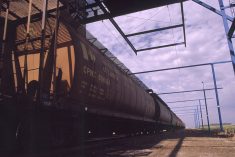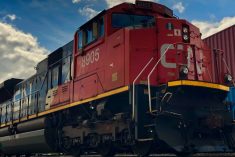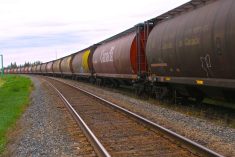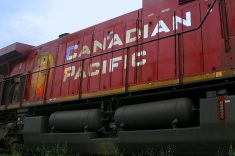The loonie’s decline since last year has led federal regulators to dial up the index guiding how much money Canada’s big two railways get to keep from hauling Prairie grain.
The Canadian Transportation Agency (CTA) announced Friday it will raise its volume-related composite price index (VRCPI) by 4.8 per cent, to 1.3275, for the 2016-17 crop year.
The VRCPI is the inflation factor in the annual maximum revenue entitlement (MRE) — that is, the revenue cap — imposed on Canadian National and Canadian Pacific Railways (CN, CP) for their handling of Prairie grain.
Read Also

Brazil to reap record soy crop in 2025/2026, increase exports
Brazil’s Conab said the country will reap a record soybean crop of 177.6 million tons in the 2025/2026 harvest year, according to data released on Thursday.
The increased VRCPI — a weighted composite of the CTA’s forecasted prices for railway labour, fuel, materials and capital spending — will be applied when the CTA sets the 2015-16 cap, a decision expected by Dec. 31, 2017.
“Nearly half” of the announced increase is owing to the sharp decline in the Canada/U.S. exchange rate between 2014 and 2015, and to forecasts for the Canadian dollar to decline “even further” in 2016, the agency said.
The weaker loonie increases the railways’ costs for materials used in “day-to-day operations,” the agency said, as CN and CP pay for many of those items in U.S. dollars.
Volatility in both the price of crude oil and the exchange rate make fuel prices “very difficult” for expert forecasters and the CTA to predict with a high level of accuracy, the agency said.
In the 4.8 per cent increase, the CTA said, 2.2 per cent is based on the use of “actual” preliminary data to replace last year’s forecasts of price changes, along with revised forecasts for 2016.
The CTA said its material price forecasting model last year “underestimated” the price change for railway materials, partly because the third-party forecasts it used for the Canada/U.S. exchange rate for 2015 and 2016 were too high.
Also, the CTA said, a weaker dollar increases the railways’ leased car costs, since lease rates are often negotiated in U.S. dollars.
Another 1.2 per cent is based on revised index weights, in turn based on the 2014 financial statements from CN and CP. The remaining 1.4 per cent increase is based on forecast price changes for “railway inputs” for the 2016-17 crop year. — AGCanada.com Network














